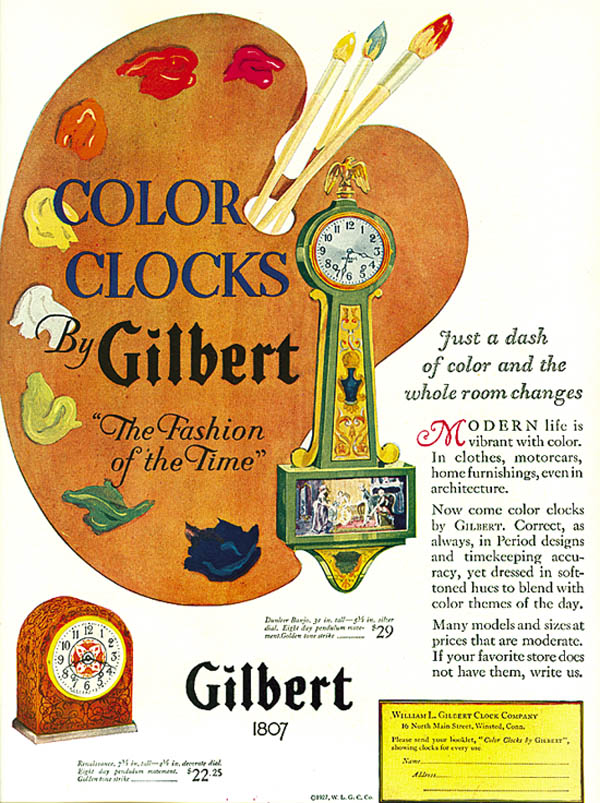It's About Time (And Clocks!)
Round and round, round and round.
The hands on the clock go round and round.
To tell us the time.
The Clock Song
And there you have it. Telling us the time. Thats what clocks do. From tiny travel alarms to massive walnut grandfathers, ancient sundials to up-to-the-minute digital readouts, we depend on clocks for one thing, and one thing only: to let us know what time it is. Without them, wed be late for work. Wed miss our dental appointments. The brownies would overbake. And the kids would be left waiting in the rain after soccer practice.
We rely on clocks to bring just a bit of order into our hectic modern lives. Clocks keep things running like. . .well. . .like clockwork!
Its About Time
Clocks are a prime example of form following function. In their earliest incarnations, the functionality of a timepiece was of paramount importance. Was it telling the time? More importantly, was it telling the correct time? Once those basic questions had been answered satisfactorily, (and it took awhile), designers had all the time in the world to experiment with form. But first: an overview on the history of time-keeping, (presented in record time):
The earliest means of telling time offered, at best, rough estimates, and each had its drawbacks. Sundials were fairly accurate, but useless on a cloudy day, or at night. Water clocks demonstrated similar inaccuracies, since most relied on sundials for their calibration. Candle clocks, which burned down to marked notches, maintained a steady pace - unless it was windy. Then there was the hourglass. Sand trickled steadily from one upended globe to another; when the top portion was empty, the time was up. But just how much time had actually passed? Determining that was arbitrary, and dependent on such variables as outside temperature, sand density, and hourglass size. (Incidentally, by my calculations, the Wicked Witch's hourglass in The Wizard of Oz, gigantic though it is, only takes about 6 minutes to empty. Thats how much time passes from the moment when the Witch turns it over, to the moment when Dorothys pals rush to her rescue.)
What Makes It Tick?
Greater precision was called for, and, during the Middle Ages, European monks, (or at any rate, the blacksmiths they employed), developed mechanical clocks, massive frameworks of interlocking iron gears linked to church bells. Since these solemnly and consistently tolled the hours, the faithful no longer had a good excuse for missing services. For home use, (wealthy homes, that is), spring-driven clocks proved a less cumbersome, and fairly reliable alternative, at least as long as the springs were kept wound.
Then came Galileo, and the pendulum clock. It was just about 1580 when the astronomer discovered that a cathedral lamp, hanging from a chain, swung back and forth at a measured rate. Shorten or lengthen the chain, and the rate adjusted accordingly. Galileo died before his theory could be applied to clock construction, but in 1656 the time proved right for a pendulum clock designed by Christian Huygens. Previous mechanical clocks had lost or gained up to a half-hour daily. The pendulum clock varied just a few seconds each week.
Since then, whether pendulum or spring, electric or digital, clocks have achieved their tick-tocking goal through oscillation. The same repetitive to-and-fro motion occurs at regular intervals. That motion is counted in established units, (second, minutes, and so forth), then displayed in some manner, (such as a clock face), for all to see. Thanks to oscillation, running late has become a thing of the past. (Well, in an ideal world, that is.)
The electric clock made its debut in 1840, further condensing clock size. With the introduction of electronics in the twentieth century, almost all traditional clockwork parts were eliminated, allowing clocks to become much more compact, and stylistically adaptable. Ideal function had at last been achieved. By the mid-twentieth century, designers with plenty of time on their hands could at long last experiment with form.
Another Time, Another Place
Lavish Art Deco clock stylings of the 1920s and 1930s took delight in gilding the lily. The clock became an art object, designed with the same delicacy and attention to exterior detail as a painting or sculpture. Fashioned of materials ranging from marble, exotic woods, and ivory, to glass, bronze, and even wedges of Bakelite, Art Deco clocks were so lovely that it was actually an unexpected bonus if they kept perfect time. A 1928 ad for prominent clock manufacturer Gilbert extolled the companys wares as ideally suited to the fashion of the time, since modern life is vibrant with color. In clothes, motorcars, home furnishings, even in architecture. Well-heeled consumers agreed, and clamored for increasingly more elaborate clocks. The Parisian firm, Leon Hatot, for instance, offered a clear glass stunner with hands and numerals of silver. Expensive even in their day, such creative gems retain their pricey allure the second time around. In todays collectors market, the going rate for a Hatot is $4,000 to $5,000. When author Alastair Duncan proclaimed Art Deco, (a term he coined), as the last truly sumptuous style he wasnt kidding.
For The Good Times
At the opposite end of the time-space continuum were clocks for the budget-conscious. Particularly during the Depression years of the 1930s, inexpensive novelty clocks found favor in homes across America. While less extravagantly outfitted than their high-end Deco contemporaries, these wall and mantel clocks provided good value for the money. Most retailed at $10 or less, and their themes had a uniquely whimsical appeal.
Prominent among them were molded-wood clocks by Syroco (Syracuse Ornamental Company). The complete Syroco inventory encompassed everything from brush holders to bookends, offering the look of hand-carved wood at a fraction of the cost. When it came to clocks, it didn't matter if your tastes veered to the figural (monks, waiters, clowns), the animal (cats, parrots, camels), or the cheerily nostalgic (windmills, rustic scenic views). Whatever the preference, Syroco had a clock for you. The mechanism was by Lux, the body by Syroco, the finished clock both affordable and endearing.
Time To Start Livin
Also popular: inexpensive novelty clocks ideally suited for a specific room in the home. (Seth Thomas, for example, turned out an entire orchard of kitchen-ready Red Apple clocks). Some companies specialized in clocks with added oomph. Haddons Ship Ahoy clock lamp had a sailboat rocking on its painted waves, while MasterCrafters ceramic clocks replicated the pendulum effect with moving figures, such as children on swings, or old folks in rocking chairs.
A best-seller among mid-century novelties (and still in production today): the Kit-Cat Clock, with his pendulum tail, hypnotic moving eyes, and eerily close resemblance to Felix the Cat. Premiering in basic black, the Kit-Cat has, over the years, updated his wardrobe to include fire-engine red, restful aqua, and even a multi-color splash of sequins.
And, possessing an irresistible kitschy charm: souvenir clocks, from locales as diverse as New York and Las Vegas. What better way to travel back in time than with a Statue of Liberty Clock, (complete with glowing torch), or a sparkly Vegas version, with casino dice marking the hours?
Ahead Of Their Time
After a time-out imposed by the production restraints of World War II, postwar designers were eager to take a plunge into uncharted waters. During the 1950s and 1960s, fresh shapes, materials, and means of expression combined to create what we now refer to as mid-century modern. Among the items spruced up and streamlined for a brand-new age: housewares. Among those housewares: clocks.
Firmly tugging at the modern timeline were clock lamps by Moss Manufacturing of San Francisco. Moss was a line was born of necessity. With metal usage curtailed by the war, the lamp-making firm sought out another basic material, not subject to rationing. The answer: Plexiglas, which was not only readily available, but could be easily cut and glued into any shape imaginable. Moss matriarch Thelma Moss, never at a loss for imagination, inspired her designers to let their creativity run rampant. The result: a line of space-age Plexi eye-poppers, equally at home in a 1950s living room, or aboard a flying saucer.
Focusing first on lamps, Moss soon roved through the mid-century home like a Plexiglas Godzilla, seeking other items ripe for re-invention. Moss clocks, in particular, exhibit a mastery of multi-purposing. They tell time. They light up. They hold flowers. Many even include that Moss specialty, the rotating platform. Flick the switch, and a ceramic figurine, (often by a prominent design name, such as deLee, Hedi Schoop, or Lefton), begins its stately twirl. Thanks to Moss, clocks had come a long way since the days of the sundial.
Modern Times
Equally modern, yet less over-the-top, were fused glass clocks by Higgins Glass Studio of Chicago. Although artisans such as Georges Briard also designed glass clocks, those by Michael and Frances Higgins are among the mid-centurys most innovative. Clocks were a natural outgrowth for these pioneers of practical design, whose decorative housewares ran the gamut from cigarette boxes to candleholders, platters to Posey Pockets. Noted Michael, We try to make things which may be thought beautiful. But we are not ashamed if our pieces are useful. Indeed, we often prefer it, because it makes them easier to sell.
Higgins glass clocks fill the bill on both counts - beauty and usability. A 1954 Higgins clock for General Electric, featuring ball-tipped rays radiating outward on the glass face, is as unexpectedly glorious as an alien sun. A later line of glass-on-glass clocks was created for Haddon during the Higgins stay at Dearborn Glass Company. The hours are indicated by colorful glass chunks fused to a vibrantly patterned glass slab. While from the mid-century, a Higgins clock is not of the mid-century. Simplicity and clarity of line, coupled with a bold use of color, make Higgins clocks right at home in any age. In other words, theyre timeless.
As Time Goes By
Deco dazzlers. Moss marvels. Captivating Kit-Cats, Higgins must-haves, and rococo Syroco. Theres no time like the present to explore the limitless treasure trove of mid-twentieth century clocks. But take your time. Enhance the present by embracing, and thoroughly enjoying, the past. Which clock will be your favorite? Only time will tell.
Donald-Brian Johnson is the co-author of numerous Schiffer books on mid-twentieth century design, including the recently released Postwar Pop. Please address inquiries to: donaldbrian@msn.com (Don promises to answer in a timely fashion!)

Donald-Brian Johnson
Donald-Brian Johnson is a nationwide columnist, and the co-author of numerous Schiffer books on design and collectibles. His most recent, "Postwar Pop," is a collection of his columns.














